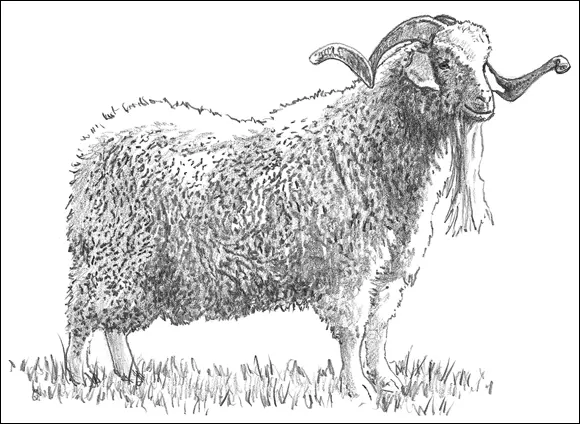Moneymaker meat goats were developed by Bob and Dusty Copeland of California by first crossbreeding Saanens and Nubians and then adding Boers into the mix. This crossbreed has the advantage of easy kidding, often with triplets. In addition, the does are able to put the desired weight on kids within four or five months of nursing. The breeders have found that the ideal mix is 75 percent Boer and 25 percent Saanen/Nubian cross.
Another South African meat breed brought to the United States is the Savanna. These goats are known for their heat and drought resistance and excellent mothering abilities. Savannas are a muscular breed with long ears, thick black skin, and a short white coat that develops a nice, fluffy cashmere undercoat for additional warmth during the winter. They are highly adaptable to a variety of unpleasant weather conditions, having done well in both Canada and the southeastern United States.
Because international law now prohibits bringing in any new genetic material, these goats are expensive and harder to come by.
Investigating Fiber Goats
If you are a home spinner or want to get your own supply of fiber, consider the fiber goats. Angoras produce the fiber called mohair, which is a silky fiber used in many products. Cashmere, produced by the cashmere goat, is an even more exotic fiber and is in high demand. It comes from the undercoat of these goats.
Fiber goats, if you properly care for them, take a bit more work than some of the other goats. You can choose from medium to small goats in a variety of colors. If you want meat, some of these are dual-purpose goats.
A number of registries exist for fiber goats, mostly depending on the breed, but in two cases specifically for colored fiber goats. These include the American Angora Goat Breeders Association (AAGBA), the Cashmere Goat Association (CGA), the Pygora Breeders Association (PBA), the PCA Goat Registry, and the Colored Angora Goat Breeders Association (CAGBA).
While CAGBA is only for Angoras, the PCA Goat Registry is hybrid-based, registering goats whose parents are already registered by CAGBA, PBA, NPGA, and AAGBA.
In the upcoming sections, I tell you about the choices you have in fiber goats and some of the pros and cons of each.
Angoras have long, wavy coats, with fiber called mohair. (Angora fiber comes from rabbits.) They are usually white, but some breeders are experimenting with producing other colors. Their horns can be long or short and are curved or spiral, in the case of bucks. They are usually left on the goat, because they may regulate body temperature. The average adult goat produces 8 to 16 pounds of mohair each year, while kids give from 3 to 5 pounds of longer, finer hair. Figure 3-8 shows an Angora buck.

FIGURE 3-8:An Angora buck.
Angora goats came from Turkey, and their name is derived from the city of Ankara, which used to be called Angora. These goats were first brought to the United States in 1849. Since then their popularity has grown, so that now the United States is one of the biggest producers of mohair. Most of the producers are in Texas.
 If you’re wondering whether anyone has tried crossing Angoras with cashmeres, the answer is yes. But the resulting goats — called Cashgoras — were a bit of a flop, producing fiber that isn’t as useful or as high-quality as the original products.
If you’re wondering whether anyone has tried crossing Angoras with cashmeres, the answer is yes. But the resulting goats — called Cashgoras — were a bit of a flop, producing fiber that isn’t as useful or as high-quality as the original products.
Angoras may be raised on a range, but in that case a couple of problems arise. They are sensitive to temperature and cold, and wet weather can kill them. They also are not natural mothers and so they sometimes abandon their kids. The kids often need help to get started nursing. And with twins and triplets, the bigger kids hog all the milk if not controlled, leaving the little ones nothing to eat.
Cashmere goats in the United States aren’t a breed but a type of goat. What makes a goat a cashmere goat is that it produces cashmere. According to the Eastern Cashmere Association, feral goats from Australia and Spanish goats in the United States are both cashmere producers. They just need to have been bred to produce the right quality of cashmere, a measurement that is determined by the cashmere industry. (The fiber has to be less than 19 microns thick.) Most of the larger cashmere breeders originally imported high-quality fiber goats from Australia to start their herds.
Cashmere goats are dual fiber/meat goats. Like their non-cashmere feral relatives, they are quite hardy. But like dairy goats (and the Wicked Witch of the East) they don’t like rain and will run for shelter when it comes. Refer to Figure 3-7, which shows a Spanish cashmere goat.
U.S. cashmere goats are a little smaller than standard dairy goats but larger than Nigerians, making them a medium-sized goat. The bucks weigh about 150 pounds and does about 100 pounds at maturity. Like the Angora, they aren’t disbudded, because their horns help them regulate temperature so their heavy coats don’t overheat them.
The cashmere is actually their downy undercoat. Their outer coat, called guard hair, is quite coarse and isn’t used for fiber.
 Cashmere production in the United States is still a small market, so if you get cashmere goats, you will be part of an elite group. Breeders with large herds remove the cashmere once a year, between December and March. That’s because it grows in response to light — from the summer solstice until the winter solstice. If you don’t have a lot of goats, you can just comb out the cashmere when it starts to shed. The average cashmere goat produces only about 4 ounces of cashmere per year.
Cashmere production in the United States is still a small market, so if you get cashmere goats, you will be part of an elite group. Breeders with large herds remove the cashmere once a year, between December and March. That’s because it grows in response to light — from the summer solstice until the winter solstice. If you don’t have a lot of goats, you can just comb out the cashmere when it starts to shed. The average cashmere goat produces only about 4 ounces of cashmere per year.
I haven’t yet seen or heard of a miniature meat goat (probably because they don’t make enough burger), but people seem to have a general predilection for miniaturizing animals. That tendency applies to fiber goats, as well as the dairy goats.
You find two different breeds of mini fiber goats in the United States — the Pygora and the Nigora. As you can tell by their names, both are crosses with the Angora.
The Pygora is a cross between the Pygmy and the Angora that was started by Katherine Jorgensen in Oregon. She wanted to use the fiber for hand-spinning. The Pygora is a small, easy-to-handle, and good-tempered fiber goat. These little guys are registered by the Pygora Breeders Association (PBA), which started in 1987. A Pygora can be up to 75 percent of either breed.
Pygoras come in the same colors as Pygmies. Does weigh between 65 and 75 pounds, while bucks and wethers are between 75 and 95 pounds. The PBA requires them to be a minimum of 18 inches tall (does) and 23 inches (bucks).
Pygoras can produce up to four pounds of fleece a year, a bit less than the full-sized Angora. They are smart and can sometimes be found in petting zoos and circuses.
Some people raise Pygoras for pets or brush-eaters and never use the fiber. Because of their longer hair, these goats are more prone to lice and should be sheared twice a year. (See Chapter 18for more about harvesting goat fiber.)
Nigoras are a cross between a Nigerian Dwarf or a mini dairy goat (Nigerian crossed with a full-size dairy goat) and an Angora. They have the advantage of producing colorful fiber, as well as milk. The American Nigora Goat Breeders (ANGBA) was started in 2007 and several groups dedicated to the breed can be found on Facebook.
Читать дальше


 If you’re wondering whether anyone has tried crossing Angoras with cashmeres, the answer is yes. But the resulting goats — called Cashgoras — were a bit of a flop, producing fiber that isn’t as useful or as high-quality as the original products.
If you’re wondering whether anyone has tried crossing Angoras with cashmeres, the answer is yes. But the resulting goats — called Cashgoras — were a bit of a flop, producing fiber that isn’t as useful or as high-quality as the original products.










